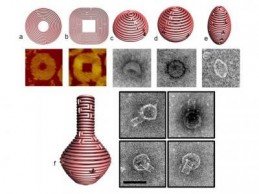New DNA nanoforms take shape
April 15, 2011

2D nanoforms (top) with accompanying images of the resulting 3D structures (credit: The Biodesign Institute Arizona State University)
A team at Arizona State University’s Biodesign Institute has expanded the capability of DNA origami to construct arbitrary 2-D and 3-D shapes, mimicking those commonly found in nature.
The designers began by making simple 2-D concentric ring structures, each ring formed from a DNA double helix. The concentric rings are bound together by means of strategically placed crossover points. These are regions where one of the strands in a given double helix switches to an adjacent ring, bridging the gap between concentric helices. Such crossovers help maintain the structure of concentric rings, preventing the DNA from extending.
Varying the number of nucleotides between crossover points and the placement of crossovers allows the designer to combine sharp and rounded elements in a single 2D form. The network of crossover points can also be designed to produce combinations of in-plane and out-of-plane curvature, allowing for curved 3D nanostructures.
Combining the method of concentric helices with non-B-form DNA (with 9-12 base pairs/turn) enabled the team to produce sophisticated forms, including spheres, hemispheres, ellipsoid shells, and a round-bottomed nanoflask.
Ref.: Hao Yan & Yan Liu et al., DNA Origami with Complex Curvatures in Three-Dimensional Space, Science, April 15, 2011